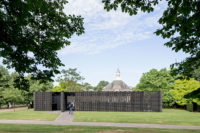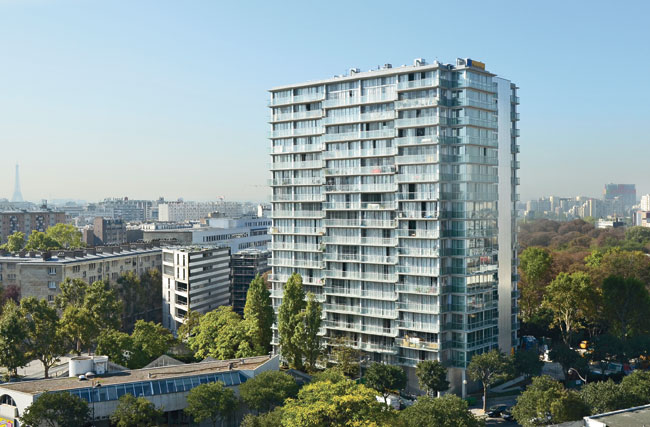Renewed Promise


















Two teams of architects employ very different strategies to reinvigorate a pair of ambitious 1960s apartment projects, one in the north of England and the other in Paris.
Bois-le-Pêtre, Paris
The $15.4 million overhaul of Bois-le-Pêtre, completed in 2011, is a more explicit manifesto for renovation. Its roots are in a combined response by Lacaton & Vassal and Frédéric Druot to the French government's 2003 demolition plan: 'We were shocked by the idea that nothing could be done except tabula rasa redevelopment,' recalls Anne Lacaton. The two architecture firms embarked on a published research project which concluded that such buildings could be repaired and expanded for half the cost of replacement. Two years later, in 2006, the authors won a competition run by the government-funded social-housing provider Paris Habitat'OPH for the renovation of the tower and put their ideas into action.
Designed by Raymond Lopez, Bois-le-Pêtre was completed in 1961, predating the adjacent eight-lane Périphérique that encircles the inner city. A facade of glass and aluminum with recessed balconies wrapped its 17-story precast-concrete frame. But in the 1980s, this lively Miesian skin was overclad with insulated panels in an attempt to improve thermal performance, shrinking the windows and lending the block a defensive air that earned it the nickname 'Alcatraz.'
It is now transformed in every respect, spatial, technical, and aesthetic, by an approximately 10-foot-deep extension on all four sides. The east and west facades were replaced with aluminum-framed double-glazed sliding doors, occupying the full width of each apartment and opening onto 6-foot-7-inch-deep winter gardens. From these enclosed, unheated terraces, sliding polycarbonate screens lead onto 3-foot-3-inch-deep balconies with glass balustrades. On the narrower north and south facades, double-glazed extensions create additional internal space, allowing an increase to the number of apartments from 96 to 100 without reducing any in size. The building has a tripartite stepped section, with floor levels at the ends a half-story above the middle. New elevators at each end make it fully wheelchair-accessible.
Enlarged from 95,800 to 134,100 square feet, the building now touches the site's street edge to the north and stretches as far as regulations allow toward a cemetery to the south. The extensions add 242 square feet of usable outdoor space to 452-square-foot one-bedroom apartments, while larger corner apartments gain 290 square feet of outdoor space and up to 430 square feet of indoor space. This increase is the key to making reuse preferable to rebuilding, says Lacaton: 'More space means more pleasure, freedom, and peace for the family.' Thanks to an agreement brokered by the architects, rents remain the same: a 1,450-square-foot, five-room apartment goes for about $950 a month.
The cost, approximately $150,000 per apartment, was higher than estimated in the architects' earlier research but compares favorably with the typical figure of over $200,000 for demolition and rebuilding. Extensive internal renovations also offer poor value in comparison with extension, says Lacaton, and involve significant disruption and expense, since residents must be moved into temporary housing. Bois-le-Pêtre's 400 residents, ranging from young families to retirees, remained in the building throughout.
To minimize disturbance, the architects designed the extension as a self-supporting steel frame, tied to the concrete frame with steel brackets. Their initial intention was to assemble it as fully prefabricated modules, including replacement facades, which would be stacked on-site, each forming a working platform for the removal of the old facade. When it became clear how long it would take to manufacture 150 modules, the plan was revised, and only the insulated steel-and-concrete floor decks were fabricated off-site.
The asbestos-ridden overcladding was stripped from each facade before the original skin was removed, apartment by apartment, with new glazing installed the same day. The framework of 24-foot-6-inch-wide floor decks and story-tall steel columns was assembled over several months. Once in place, the polycarbonate outer facades were fitted.
Large areas of glazing and operable windows are in counterpoint to much contemporary architecture, where energy efficiency is pursued through increasing airtightness and insulation, an approach that prioritizes energy performance over well-being, says Lacaton. "We try to push another way of thinking, which has the same goals but works with the sun and natural ventilation, and gives the user the responsibility to decide when to open or close windows."
Bois-le-Pêtre's extensions are part of an environmental strategy that has reduced heating-energy demand by 60 percent, says Lacaton. They shade apartments from the high summer sun, while the low winter sun penetrates the enlarged areas of glazing. In spring and fall, the winter gardens work like greenhouses, producing welcome solar gain.
The operation of the double facade is supported by two further flexible layers. The first, a half-inch-thick thermal curtain, hangs inside the glass sliding doors. Made of wool with a reflective outer face of aluminum foil, it keeps heat inside on winter nights and out on hot summer days. The second, a thin, reflective solar curtain, hangs inside the loose-fit enclosure of the winter garden. When closed, it permits views out through close-spaced vertical stripes of mesh, while its foil outer face reflects most solar radiation. In summer, when residents ventilate their apartments by opening both sets of doors with the solar curtain closed, the internal temperature can be cooler than outside by up to 10 degrees Fahrenheit; on a winter morning, with both doors closed and the curtain open, up to 20 degrees warmer.
The solar curtains are manufactured for use in commercial greenhouses. Other materials more commonly found in agricultural or industrial structures were also specified, says Lacaton, because they are easy to use and inexpensive, with minimal structural requirements. The unusual application required commitment, however; the engineer was initially reluctant to include the thermal curtains' insulating properties in calculations, since their proper use could not be guaranteed. An assumption that half the curtains will be closed on winter nights as intended was eventually agreed on.
Folds of silvery fabric, sliding screens, and signs of occupancy animate the building's layered carapace, whose refinement supports the architects' belief that an appropriate outward appearance will ensue from concern for quality of life inside. As with Bois-le-Pêtre, the renovation of Bois-le-Pêtre restores something of the building's original promise, more space, great views, and a well-tempered environment, and, through the outward manifestation of change, gives something to the city. Both are buildings first conceived in a spirit of optimism, revived by another dose.
London-based Chris Foges is editor of Architecture Today and an Architectural Record international correspondent.
PeopleLocation: Completion Date: Gross square footage: Total construction cost: Owner: Architect: Lacaton & Vassal architectes Personnel in architect's firm who should receive special credit: Engineer(s): Photographer(s)) Philippe Ruault Renderer(s): |
ProductsExterior cladding Glazing |











